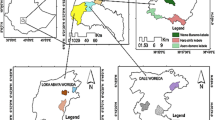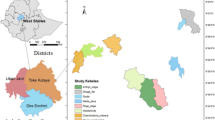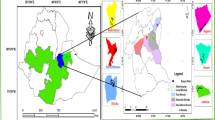Abstract
With the objective of planning diversification of on-farm tree species composition, a survey was conducted in western Kenya involving a complete tree census (trees were defined as all woody or ligneous plants, including shrubs and lianas) and collection of ethnobotanical information on 201 farms. Differences between farms in diversity of the 12 most frequent use-groups were analysed by species richness, Shannon, Simpson and Berger-Parker diversity indices, and Shannon evenness and equitability. A large range of values was detected among farms and use-groups. Multiple linear regression of diversity statistics on household characteristics indicated significant relationships. However, these relationships generally explained low percentages of variation (ranging 2-44%). The connection between household characteristics and use-group diversity allows targeting specific household types with lower diversity. Farm size had a positive relationship with diversity of most use-groups. However, accumulation curves revealed that the same area carried a larger abundance and diversity when it was composed of a greater number of smaller farms. If the pattern of further subdivision of farmland in the survey area continues and the same differences between smaller and larger farms prevail, then larger diversity per unit area can be expected. Because smaller farms contain smaller diversity, however, diversification with the aim of enhancing or stabilising productivity of individual farms may become an important priority in the survey area. The results presented allow for the identification of individual farms, use-groups, and household types for which diversification is more relevant, and at the same time allow for impact monitoring.
Similar content being viewed by others
References
Anderson M. J. and Legendre P. 1999. An empirical comparison of permutation methods for tests of partial regression coefficients in a linear model. Journal of Statistical Computation and Simulation 62: 271–303.
Bradley P. N. 1991. Woodfuel, women and woodlots, volume 1. Macmillan Education Ltd, London and Basingstoke, 338 pp.
Cromwell E. and van Oosterhout S. 2000. On-farm conservation of crop diversity: policy and institutional lessons from Zimbabwe.. In: Brush SB (eds), Genes in the field: on-farm conservation of crop diversity, pp. 217–238., 165–191. IPGRI IDRC and Lewis Publishers, Boca Raton, Florida, USA.
David S. and Swinkels R. 1994. Socio-economic characteristics of households engaged in agroforestry technology testing in Western Kenya. International Centre for Research in Agroforestry, Nairobi, Kenia, 33 pp.
Den Biggelaar C. 1995. When a woman is a man: inter-and intra-gender differences in tree tenure and planting in Rwanda. Agro-forestry Today 7: 13–15.
Dover M.J. and Talbot L.M. 1987. To feed the earth: agro-ecology for sustainable development. Mohan Primlani for Oxford and IBH Publishing Co. Pvt. Ltd, New Delhi, India, 96 pp.
Hector A., Schmid B., Beierkuhnlein C., Caldeira C., Diemer M., Dimitrakopoulos P.G., Finn J.A., Freitas H., Giller P.S., Good J., Harris R., Högberg P., Huss-Danell K., Joshi J., Jumpponen A., Körner C., Leadley P.W., Loreau M., Minns A., Mulder C.P., O'Donovan G., Otway S.J., Pereira J.S., Prinz A., Read D.J., Scherer-Lorenzen M., Schulze E.D., Siamantziouras A.D., Spehn E.M., Terry A.C., Troumbis A.Y., Woodward F.I., Yachi S. and Lawton J. 1999. Plant diversity and productivity in European grasslands. Science 286: 1123–1127.
Helmers G.A., Yamoah C.F. and Varvel G.E. 2001. Separating the impacts of crop diversification and rotations on risk. Agronomy Journal 93: 1337–1340.
Holmgren P., Masakha E.J. and Sjoholm H. 1994. Not all African land is being degraded: a recent survey of trees on farms in Kenya reveals rapidly increasing forest resources. Ambio 23: 390–395.
ICRAF 2000. Paths to prosperity through agroforestry. ICRAF's corporate strategy 2001–2010. International Centre for Research in Agroforestry, Nairobi, Kenia, iii+43 pp.
Jaetzhold R. 1982. Farm management handbook of Kenya: natural resources and farm management information vol. iia - West Kenya (Nyanza and western provinces). Kenya Ministry of Agriculture, 397 pp.
Jarvis D.I., Myer L., Klemick H., Guarino L., Smale M., Brown A.H.D., Sadiki M., Sthapit B. and Hodgkin T. 2000. A training guide for in situ conservation on farm. Version 1. International Plant Genetic Resources Institute, Rome, Italy, 161 pp.
Kindt R. 1997. Local perceptions on tree propagation and domes-tication - results from a survey in western Kenya. International Centre for Research in Agroforestry, Nairobi, Kenia, 45 pp.
Kindt R. and Lengkeek A.G. 1999. Tree diversity on farm - use it or lose it.. In: National workshop on agricultural biodiversity conservation, 27–29 January 1999, Nairobi, Kenia, pp. 75–85. Intermediate Technology Development Group (ITDG).
Legendre P. and Legendre L. 1998. Numerical ecology. Elsevier Science BV, Amsterdam, The Netherlands, 853 pp.
Long J., Cromwell E. and Gold K. 2000. On-farm management of crop diversity: an introductory bibliography. Overseas Development Institute for ITDG, London, UK, 42 pp.
Loreau M., Naeem S., Inchausti P., Bengtsson J., Grime J.P., Hector A., Hooper D.U., Huston M.A., Raffaelli D., Schmid B., Tilman D. and Wardle D.A. 2001. Biodiversity and ecosystem functioning: current knowledge and future challenges. Science 294: 804–807.
Magnussen S. and Boyle T.J.B. 1995. Estimating sample size for inference about the Shannon-Weaver and the Simpson indices of species diversity. Forest Ecology and Management 78: 71–84.
Magurran A.E. 1988. Ecological diversity and its measurement. Princeton University Press, Princeton, New Jersey, USA, 179 pp.
Mathsoft I. 1999. S-Plus 2000 user's guide. MathSoft Inc., Seattle, Washington, USA, 558 pp.
Mortimore M., Harris F.M.A. and Turner B. 1999. Implications of land use change for the production of plant biomass in densely populated Sahelo-Sudanian shrub-grasslands in north-east Nigeria. Global Ecology and Biogeography 8: 243–256.
ter Braak C.J.F. 1986. Canonical correspondence analysis: a new eigenvector technique for multivariate direct gradient analysis. Ecology 67: 1167–1179.
Tóthmérész B. 1995. Comparison of different methods for diversity ordering. Journal of Vegetation Science 6: 283–290.
Trenbath B.R. 1999. Multispecies cropping systems in India. Agroforestry Systems 45: 81–107.
Van Noordwijk M. and Ong C.K. 1999. Can the ecosystem mimic hypotheses be applied to farms in African savannahs? Agroforestry Systems 45: 131–158.
Author information
Authors and Affiliations
Rights and permissions
About this article
Cite this article
Kindt, R., Simons, A.J. & Van Damme, P. Do Farm Characteristics Explain Differences in Tree Species Diversity among Western Kenyan Farms?. Agroforest Syst 63, 63–74 (2004). https://doi.org/10.1023/B:AGFO.0000049434.54654.97
Issue Date:
DOI: https://doi.org/10.1023/B:AGFO.0000049434.54654.97




